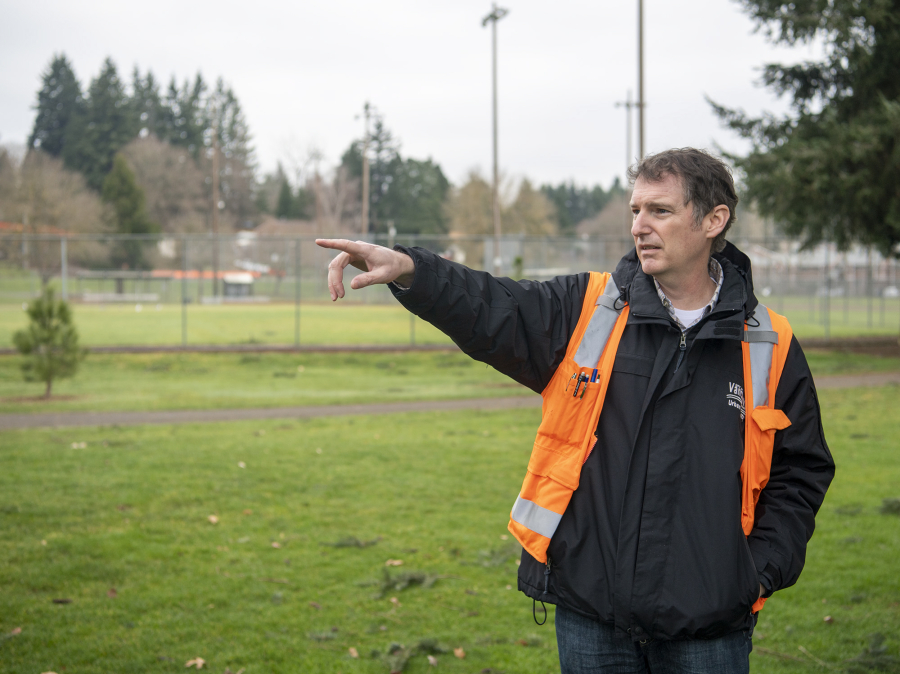In recent years, Vancouver has become abundantly dotted with trees so young they need supportive stakes to encourage their skybound posture, avoiding any potential for crookedness.
When mature, these dependent twigs will become forests destined to provide those nearby with cool shade, fresh air and clean water. Like Vancouver’s roads and buildings, canopies mixed with coniferous and deciduous trees are significant infrastructure that future generations will rely on.
Yet not all city districts have them, and those that don’t are likelier to be low-income, home to more people of color and suffer from higher health disparities, said Hilary Franz, Washington’s commissioner of public lands.
As climate change impacts become more severe, notably through heat domes and islands, the need for equitably placed canopies is becoming more immediate.
PUBLIC MEETING
Who: Vancouver’s Urban Forestry team.
What: In-person community meeting to provide an update on its management plan and receive feedback from the public.
When: 10 a.m. to noon on March 18.
Where: Martin Luther King Elementary, 4801 Idaho St., Vancouver.
HOW TO HELP
To find volunteering opportunities, visit www.cityofvancouver.us/publicworks/page/urban-forestry.
It’s a reality that local leaders are familiar with.
As urban forester Charles Ray walked through central Vancouver’s 15-acre Bagley Community Park recently, he pointed to dozens of saplings that control the field and surrounding areas.
Some are tucked in aged Douglas firs’ large shadows, and several more exist in sections unobscured by such dark patches. Thin trees with smooth bark line Plomondon Street, community buildings and sports fields.
This young colony emerged from the city of Vancouver’s latest initiatives to achieve tree equity, otherwise known as an effort to ensure urban forests are equally dispersed throughout the city, Ray said. Bagley Downs is one of a handful of high-priority areas city officials and its partners are focusing on.
Only 19 percent of Vancouver has a tree canopy — roughly 6,000 acres, or 4,600 football fields worth of cover.
American Forests, a nonprofit centered on forest health, developed a tree equity score sheet for municipalities nationwide based on the composition of an area’s demographics and ecosystem. According to its data, Vancouver has a score of 78, with 100 serving as the golden standard of tree equity.
It reported that people of color and those in poverty disproportionately have less tree canopy when compared to Vancouver’s mean tree cover percentage.
To get Vancouver to a score of 100, the city would need to introduce 672,949 trees to the community, according to American Forests.
“It’s not terrible, but there is room for improvement,” Ray said.
Rooting the groundwork
The city of Vancouver, armed with its own lofty environmental ambitions, is seeking to revise its urban forestry management plan — last updated in 2007 — to define how it can inch toward achieving tree equity.
This road map will also reflect items included in the city of Vancouver’s Climate Action Framework, which set a goal of reaching a 28 percent tree canopy by 2030 through municipal planting projects.
The state Department of Natural Resources awarded $20,000 to Vancouver to tackle its planning process, which city officials directed toward consulting fees with PlantIT Geo. According to the state agency, the grant was awarded in large part because Vancouver’s work was deemed as an environmental justice project.
During a virtual community workshop Wednesday, PlantIT Geo consultants said there is ample room for expanding the city’s current tree canopy, with more than 30 percent of plantable land existing within Vancouver.
But these urban forests aren’t born, they are made — and public involvement is a necessity. With this in mind, matched with unavoidable tree loss through citywide developments, community members are remaining cautiously optimistic on how increasing Vancouver’s urban forest will be realized.
Tonya Enger of Vancouver asked how property management companies could be given incentives to plant trees, while others questioned how developers would be held accountable to properly restore lost canopy.
“Everyone has a role to play in tree growth,” Ray said, adding that the city is continuing to build partnerships and hold companies accountable for lost trees.
Chris Peiffer, PlantIT Geo project manager, said staff will conduct public engagement through April to compose a plan that will address these issues, as well as challenges brought on by climate change. Staff predict they will finish a draft plan around May, which will be presented to the Vancouver City Council shortly after for an adoption vote.
For more information about Vancouver’s urban forestry management plan, visit www.beheardvancouver.org/ufmp or reach out to urbanforestry@cityofvancouver.us.
A sweeping issue
Washington, a state known for its lush, dense forests, is losing its trees to disease, drought and pest infestations, including the emerald ash borer, Franz said.
“We’ve been taking our trees for granted for too long,” she said.
Tree equity wasn’t always a major focus in the Evergreen Communities Act — legislation that provides urban forestry grants — when it was established in 2008. With climate change intensifying in recent years, the Department of Natural Resources has increased its advocacy for more program funding to tackle equity in climate change mitigation, Franz said.
The effort paid off in the agency’s latest grant cycle, which provided $550,000 to projects across Washington — a 700 percent jump from the previous fiscal year.
By looking at this jump in funding and applications, Franz argued, there is a demand and interest to address environmental justice through urban forestry. Although Washington’s forest health is declining, it isn’t too late to push for action.
“Yes, we should have started 50 years ago,” she continued, “but just starting today will make improvements for our community five years in the future.”




